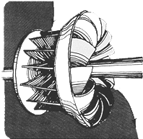Hydroelectric Power
 While hopes were high for the future of electric power, the Sacramento Electric Power and Light Company had its problems with this new technology. One of the generators ran out of control in 1901, shattering the armature, and the sand, silt, and small gravel that washed into the penstocks from the forebay wore down and damaged the turbine blades on a regular basis.
While hopes were high for the future of electric power, the Sacramento Electric Power and Light Company had its problems with this new technology. One of the generators ran out of control in 1901, shattering the armature, and the sand, silt, and small gravel that washed into the penstocks from the forebay wore down and damaged the turbine blades on a regular basis.
Despite these setbacks, the Livermores and Gallatin remained confident that electrical power had a solid future. Demand for more electricity continued to grow in the Sacramento Area. Responding to this, they built another, smaller powerhouse in 1897, just below the main powerhouse at the mouth of the tailrace, to take advantage of the 25-foot difference in elevation. This power plant had only one 750 kilowatt generator, powered by a unique continuous rope drive from the turbine.
The success of hydroelectric power development and the expanding popularity of electricity for lighting and for industry and public transportation soon outstripped the capacity of the Folsom Plant. Within a few years after the second powerhouse was built at the Folsom complex, businessmen, investors, and engineers were constructing hydroelectric plants (with more powerful generators) that harnessed water from the Feather River down to the Tuolumne River for rapidly expanding distribution networks providing current to homes and factories in the San Francisco Bay Area.
 By the early 1900s, the Folsom Powerhouse was on the brink of becoming an obsolete plant. The unpredictability of the American River water flows continued to plague the Folsom Powerhouse to the point that power transmission to Sacramento began to be interrupted on an intermittent basis. The Livermores were forced to buy electricity from the new Colgate hydroelectric plant on the Yuba River, which was owned by the San Francisco-based California Gas and Electric Company. By 1902-1903, that company had acquired the Folsom Powerhouse, along with several other power plants in the foothills. In 1906, this firm was reorganized to form the Pacific Gas and Electric Company, and from that time on, the Folsom Powerhouse remained in the control of P.G.&E.
By the early 1900s, the Folsom Powerhouse was on the brink of becoming an obsolete plant. The unpredictability of the American River water flows continued to plague the Folsom Powerhouse to the point that power transmission to Sacramento began to be interrupted on an intermittent basis. The Livermores were forced to buy electricity from the new Colgate hydroelectric plant on the Yuba River, which was owned by the San Francisco-based California Gas and Electric Company. By 1902-1903, that company had acquired the Folsom Powerhouse, along with several other power plants in the foothills. In 1906, this firm was reorganized to form the Pacific Gas and Electric Company, and from that time on, the Folsom Powerhouse remained in the control of P.G.&E.
Although surpassed in capacity and efficiency by newer, larger power plants in the P.G.&E. system, the Folsom Powerhouse still was capable of supplying electricity at a reasonable cost. The company continued to update its operation, and installed new governors in 1906, with new transformers on the second floor. In 1916, Sacramento County built a concrete bridge over the mouth of the forebay for the Leidsdorff Street connection to Greenback Lane, across the river to Orangevale. Construction of the bridge probably lead to installation of the iron pipe railings and electric lights around the forebay for public safety.
P.G.&E. drawings indicate that several substantial changes occurred at the Folsom Powerhouse in 1918, or just thereafter. Four large transformers and three large oil switches were installed just north of the main powerhouse. The one-story, long rectangular building up the hill to the west of the powerhouse was probably constructed not long after the transformers went in. It provided office space for the plant manager, a machine shop/blacksmith shop, and an automobile garage for the powerhouse. The lower powerhouse underwent substantial changes, too. Its original generator was removed and taken to another power plant in the P.G.&E. system. After considering abandoning this facility altogether, the company decided to install a new generator. A new storage building was also built at the south end of the main powerhouse. Finally, there was extensive landscaping put in around the office/shop building in an attempt to beautify the grounds at the powerhouse.
